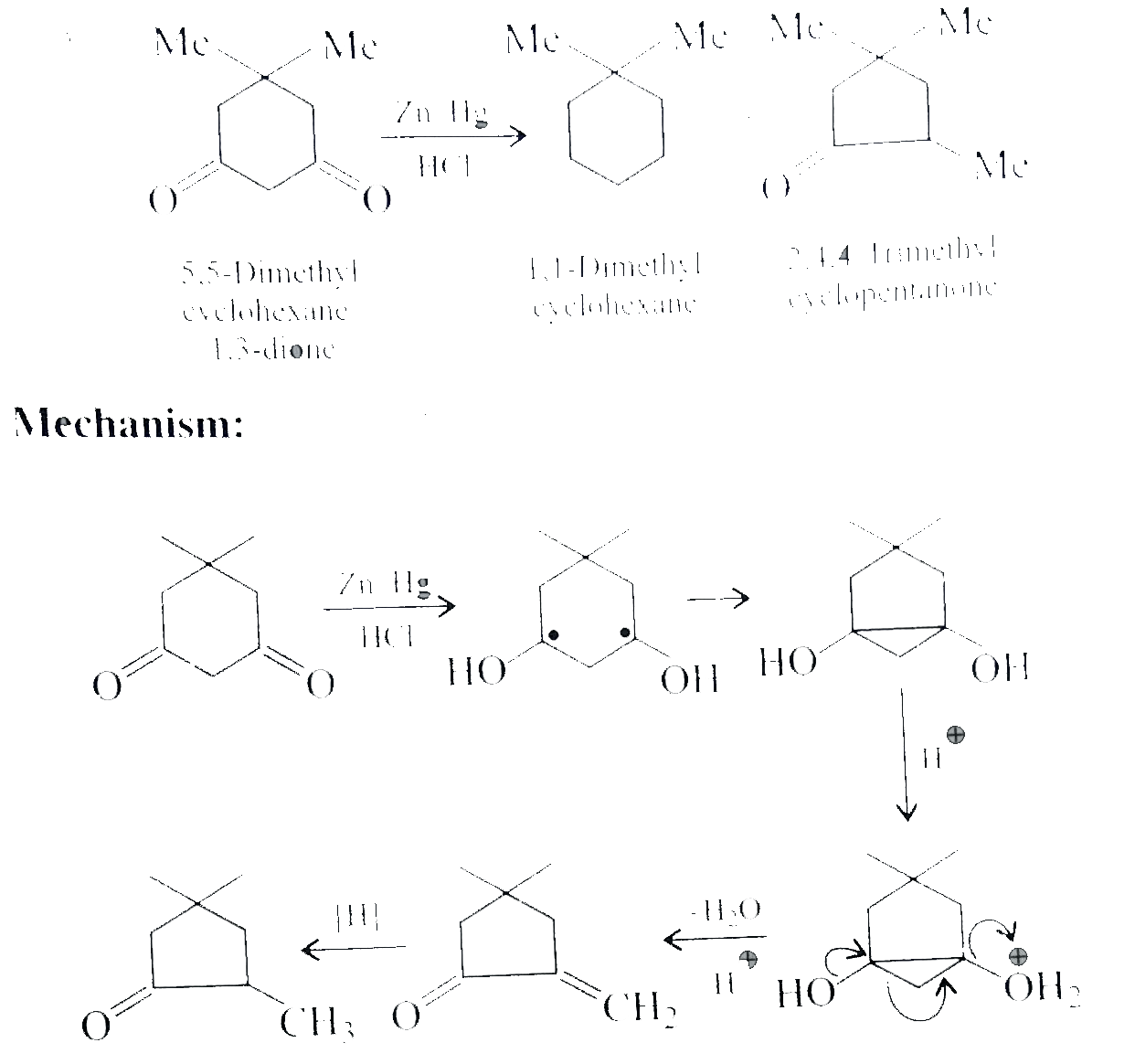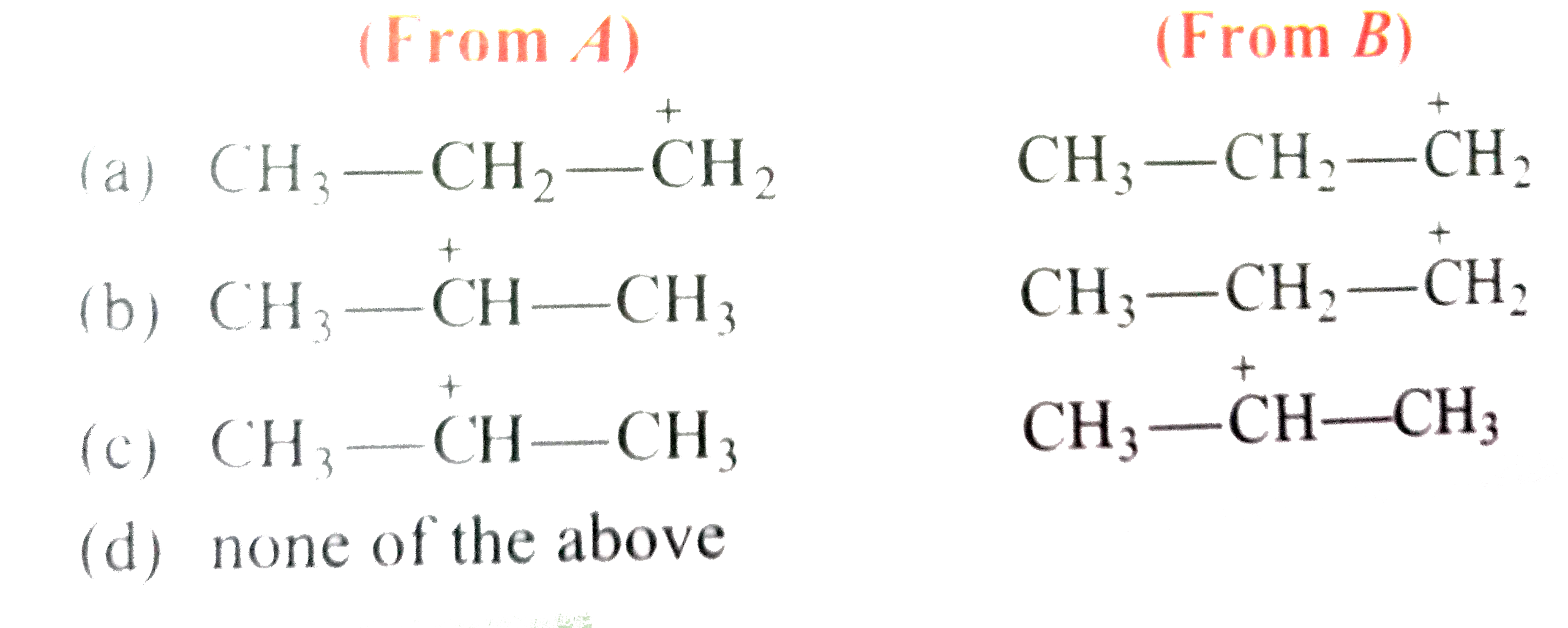Certain cyclic 1, 3-diketone give, under Clemmensen reduction, a fully reduced product along with a monoketone with ring contraction. Explain.
The formation of monoketone with contraction is through a diradical with subsequent intramolecular (C−C) bond formation with pinacol-type rearrangement.

Topper's Solved these Questions
- REDUCTION AND OXIDATION REACTION OF ORGANIC COMPOUNDSBOOK - CENGAGE CHEMISTRYCHAPTER - REDUCTION AND OXIDATION REACTION OF ORGANIC COMPOUNDSEXERCISE - Exercise (Linked Comprehension)
52 Videos
- REDUCTION AND OXIDATION REACTION OF ORGANIC COMPOUNDSBOOK - CENGAGE CHEMISTRYCHAPTER - REDUCTION AND OXIDATION REACTION OF ORGANIC COMPOUNDSEXERCISE - Exercise (Multiple Correct)
35 Videos
- REDUCTION AND OXIDATION REACTION OF ORGANIC COMPOUNDSBOOK - CENGAGE CHEMISTRYCHAPTER - REDUCTION AND OXIDATION REACTION OF ORGANIC COMPOUNDSEXERCISE - EXAMPLE
1 Videos
- QUALITATIVE INORGANIC SALT ANALYSISBOOK - CENGAGE CHEMISTRYCHAPTER - QUALITATIVE INORGANIC SALT ANALYSISEXERCISE - Viva Voce Questions And Part-C (Analysis Of Cations)
42 Videos
- SOLID STATEBOOK - CENGAGE CHEMISTRYCHAPTER - SOLID STATEEXERCISE - Ex 1.2 (Objective)
9 Videos
Similar Questions
Nitrous acid reacts with all classes of amines. The product obtained from these reactions depend on whether primary, secondary or tetriary and ,wheather the amine or aliphatic or aromatic.
Aliphalic primary amines react with acid (NaNO2+HCl) to form alcohol as major product. In , addition to alcohol, alkene and alkyl halides are also formed as minor product.
Certain cyclic primary amines can undergo either ring expansion or ring contraction reactions on treatment with acid. This reaction is called Demajanov ring expansion or contraction.

Two compounds (A) and (B) are treated with nitrous acid.

View Solution(a) How does benzene react with acetyl chloride in the presence of anhydrous AlCl3 ? Give equation
(b) (i) Write general equation of esterification reaction.
(ii) Name the product obtained when benzoic acid is heated with ammonia.
(c) Name the reagent used in the Clemmensen reduction.
View Solution
Knowledge Check
Nitrous acid reacts with all classes of amines. The nature of products obtained from these reactions depends on whether the amine is primary, secondary or tertiary. It also depends on whether the amine is aliphatic or aromatic.
Aliphatic primary amines react with nitrous acid (NaNO2+HCl) to form alcohol as the major product. In addition to alcohol, alkene and alkyl halide are also formed as minor products. Certain cyclic primary amines undergo either ring expansion or ring contraction on treatment with nitrous acid. this reaction is called Demjanov ring expansion or contraction. nitrous acid also reacts with nitroalkanes having acidic hydrogen.
Q. Which of the following product(s) will be obtained when n-propyl amine is treated with NaNO2 and HCl ?ACH3−C∣OHH−CH3BCH3−CH=CH2CCH3−C∣ClH−CH3DAll of theseNitrous acid reacts with all classes of amines. The product obtained from these reactions depend on whether primary, secondary or tetriary and ,wheather the amine or aliphatic or aromatic.
Aliphalic primary amines react with acid (NaNO2+HCl) to form alcohol as major product. In , addition to alcohol, alkene and alkyl halides are also formed as minor product.
Certain cyclic primary amines can undergo either ring expansion or ring contraction reactions on treatment with acid. This reaction is called Demajanov ring expansion or contraction.

Which of the following product(s) will be obtained when isopropylamine is treated with sodium nitrite and hydrochloric acid?ACH3−CH∣OH−CH3BCH3−CH=CH2CCH3−Cl∣CH−CH3Dall of theseNitrous acid reacts with all classes of amines. The product obtained from these reactions depend on whether primary, secondary or tetriary and ,wheather the amine or aliphatic or aromatic.
Aliphalic primary amines react with acid (NaNO2+HCl) to form alcohol as major product. In , addition to alcohol, alkene and alkyl halides are also formed as minor product.
Certain cyclic primary amines can undergo either ring expansion or ring contraction reactions on treatment with acid. This reaction is called Demajanov ring expansion or contraction.

Which of the following product(s) will be obtained in the following reactions?
 A
A B
B C
C DCH3CH2CH2CH2OH
DCH3CH2CH2CH2OH
Nitrous acid reacts with all classes of amines. The product obtained from these reactions depend on whether primary, secondary or tetriary and ,wheather the amine or aliphatic or aromatic.
Aliphalic primary amines react with acid (NaNO2+HCl) to form alcohol as major product. In , addition to alcohol, alkene and alkyl halides are also formed as minor product.
Certain cyclic primary amines can undergo either ring expansion or ring contraction reactions on treatment with acid. This reaction is called Demajanov ring expansion or contraction.

What will be the major product when 2-aminopropane is treated with nitrous acid?
View SolutionNitrous acid reacts with all classes of amines. The product obtained from these reactions depend on whether primary, secondary or tetriary and ,wheather the amine or aliphatic or aromatic.
Aliphalic primary amines react with acid (NaNO2+HCl) to form alcohol as major product. In , addition to alcohol, alkene and alkyl halides are also formed as minor product.
Certain cyclic primary amines can undergo either ring expansion or ring contraction reactions on treatment with acid. This reaction is called Demajanov ring expansion or contraction.

The product(s) obtained in the following reaction will be:

View SolutionCertain dicarboxylic acids spontaneously eliminate water when heated forming cycioc anhydirides. But for the reaction to be successfully. The cyclic anhydrides product must normally have a ring size of fivee or six members. There are two important reasons, first, the second carboxyl group can serve as the acid catalyst (by intramolecular proton transfer), as well as the nucleophile. And second, the high temperature involved reduce the need for catalyst.

Which of the following dicarboxylic acid would you expect to form cyclic anhydride?
View SolutionCertain dicarboxylic acids spontaneously eliminate water when heated forming cycioc anhydirides. But for the reaction to be successfully. The cyclic anhydrides product must normally have a ring size of fivee or six members. There are two important reasons, first, the second carboxyl group can serve as the acid catalyst (by intramolecular proton transfer), as well as the nucleophile. And second, the high temperature involved reduce the need for catalyst.

Which of the following dicarboxylic acid will not for cyclic anhydrides?
View SolutionCertain dicarboxylic acids spontaneously eliminate water when heated forming cycioc anhydirides. But for the reaction to be successfully. The cyclic anhydrides product must normally have a ring size of fivee or six members. There are two important reasons, first, the second carboxyl group can serve as the acid catalyst (by intramolecular proton transfer), as well as the nucleophile. And second, the high temperature involved reduce the need for catalyst.

Consider the following sequence of reaction,

The final product of the reaction would be
View Solution
